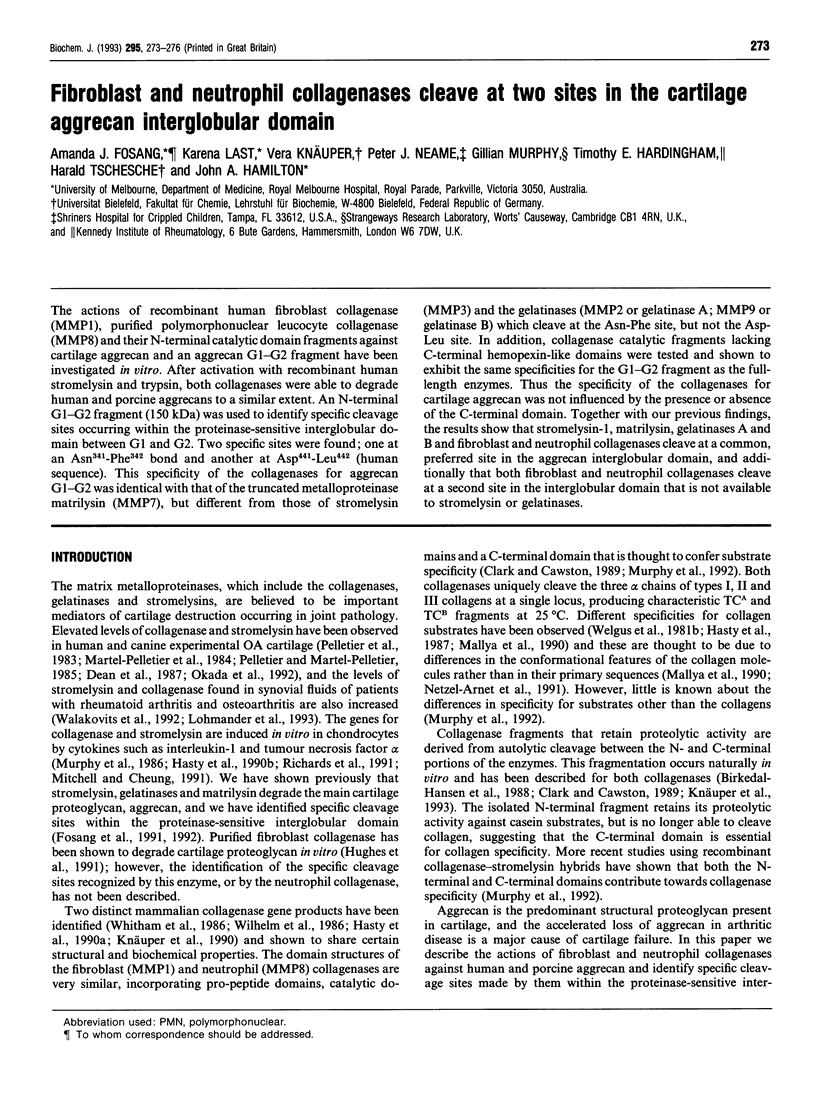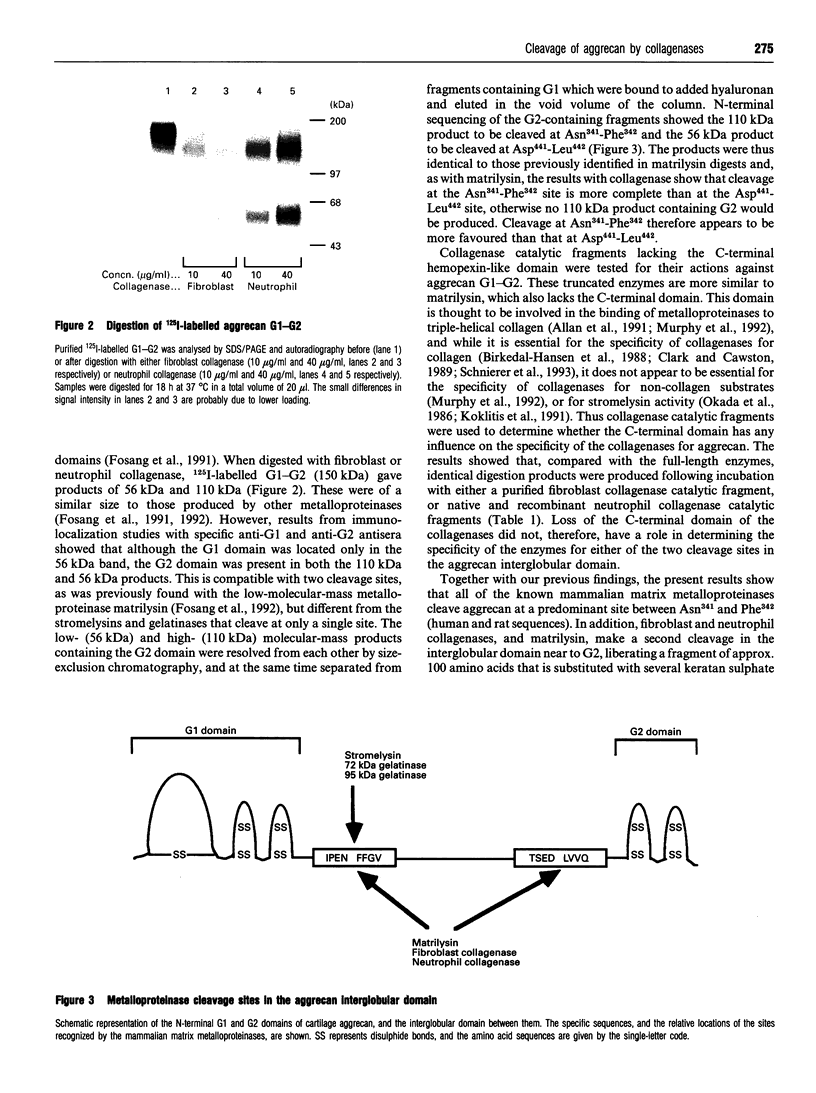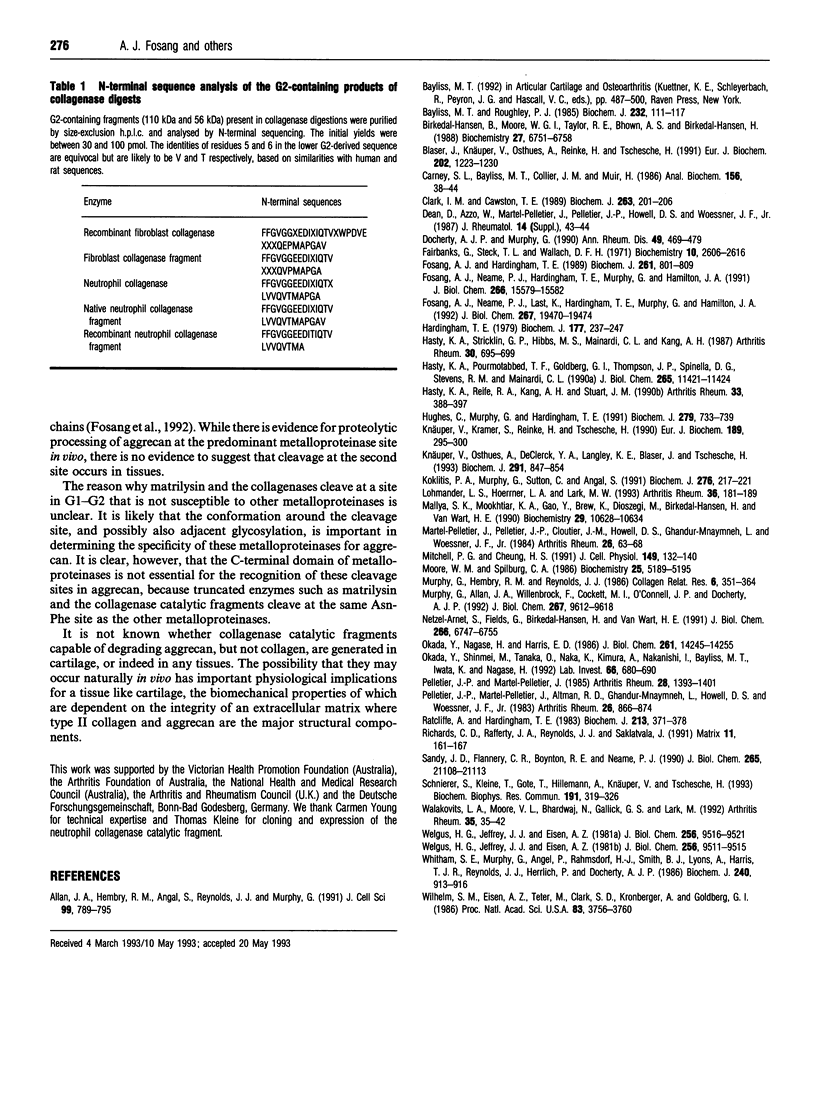Abstract
The actions of recombinant human fibroblast collagenase (MMP1), purified polymorphonuclear leucocyte collagenase (MMP8) and their N-terminal catalytic domain fragments against cartilage aggrecan and an aggrecan G1-G2 fragment have been investigated in vitro. After activation with recombinant human stromelysin and typsin, both collagenases were able to degrade human and porcine aggrecans to a similar extent. An N-terminal G1-G2 fragment (150 kDa) was used to identify specific cleavage sites occurring within the proteinase-sensitive interglobular domain between G1 and G2. Two specific sites were found; one at an Asn341-Phe342 bond and another at Asp441-Leu442 (human sequence). This specificity of the collagenases for aggrecan G1-G2 was identical with that of the truncated metalloproteinase matrilysin (MMP7), but different from those of stromelysin (MMP3) and the gelatinases (MMP2 or gelatinase A; MMP9 or gelatinase B) which cleave at the Asn-Phe site, but not the Asp-Leu site. In addition, collagenase catalytic fragments lacking C-terminal hemopexin-like domains were tested and shown to exhibit the same specificities for the G1-G2 fragment as the full-length enzymes. Thus the specificity of the collagenases for cartilage aggrecan was not influenced by the presence or absence of the C-terminal domain. Together with our previous findings, the results show that stromelysin-1, matrilysin, gelatinases A and B and fibroblast and neutrophil collagenases cleave at a common, preferred site in the aggrecan interglobular domain, and additionally that both fibroblast and neutrophil collagenases cleave at a second site in the interglobular domain that is not available to stromelysin or gelatinases.
Full text
PDF



Images in this article
Selected References
These references are in PubMed. This may not be the complete list of references from this article.
- Allan J. A., Hembry R. M., Angal S., Reynolds J. J., Murphy G. Binding of latent and high Mr active forms of stromelysin to collagen is mediated by the C-terminal domain. J Cell Sci. 1991 Aug;99(Pt 4):789–795. doi: 10.1242/jcs.99.4.789. [DOI] [PubMed] [Google Scholar]
- Bayliss M. T., Roughley P. J. The properties of proteoglycan prepared from human articular cartilage by using associative caesium chloride gradients of high and low starting densities. Biochem J. 1985 Nov 15;232(1):111–117. doi: 10.1042/bj2320111. [DOI] [PMC free article] [PubMed] [Google Scholar]
- Birkedal-Hansen B., Moore W. G., Taylor R. E., Bhown A. S., Birkedal-Hansen H. Monoclonal antibodies to human fibroblast procollagenase. Inhibition of enzymatic activity, affinity purification of the enzyme, and evidence for clustering of epitopes in the NH2-terminal end of the activated enzyme. Biochemistry. 1988 Sep 6;27(18):6751–6758. doi: 10.1021/bi00418a016. [DOI] [PubMed] [Google Scholar]
- Bläser J., Knäuper V., Osthues A., Reinke H., Tschesche H. Mercurial activation of human polymorphonuclear leucocyte procollagenase. Eur J Biochem. 1991 Dec 18;202(3):1223–1230. doi: 10.1111/j.1432-1033.1991.tb16494.x. [DOI] [PubMed] [Google Scholar]
- Carney S. L., Bayliss M. T., Collier J. M., Muir H. Electrophoresis of 35S-labeled proteoglycans on polyacrylamide-agarose composite gels and their visualization by fluorography. Anal Biochem. 1986 Jul;156(1):38–44. doi: 10.1016/0003-2697(86)90150-8. [DOI] [PubMed] [Google Scholar]
- Clark I. M., Cawston T. E. Fragments of human fibroblast collagenase. Purification and characterization. Biochem J. 1989 Oct 1;263(1):201–206. doi: 10.1042/bj2630201. [DOI] [PMC free article] [PubMed] [Google Scholar]
- Dean D. D., Azzo W., Martel-Pelletier J., Pelletier J. P., Woessner J. F., Jr Levels of metalloproteases and tissue inhibitor of metalloproteases in human osteoarthritic cartilage. J Rheumatol. 1987 May;14(Spec No):43–44. [PubMed] [Google Scholar]
- Docherty A. J., Murphy G. The tissue metalloproteinase family and the inhibitor TIMP: a study using cDNAs and recombinant proteins. Ann Rheum Dis. 1990 Jun;49 (Suppl 1):469–479. [PubMed] [Google Scholar]
- Fairbanks G., Steck T. L., Wallach D. F. Electrophoretic analysis of the major polypeptides of the human erythrocyte membrane. Biochemistry. 1971 Jun 22;10(13):2606–2617. doi: 10.1021/bi00789a030. [DOI] [PubMed] [Google Scholar]
- Fosang A. J., Hardingham T. E. Isolation of the N-terminal globular protein domains from cartilage proteoglycans. Identification of G2 domain and its lack of interaction with hyaluronate and link protein. Biochem J. 1989 Aug 1;261(3):801–809. doi: 10.1042/bj2610801. [DOI] [PMC free article] [PubMed] [Google Scholar]
- Fosang A. J., Neame P. J., Hardingham T. E., Murphy G., Hamilton J. A. Cleavage of cartilage proteoglycan between G1 and G2 domains by stromelysins. J Biol Chem. 1991 Aug 25;266(24):15579–15582. [PubMed] [Google Scholar]
- Fosang A. J., Neame P. J., Last K., Hardingham T. E., Murphy G., Hamilton J. A. The interglobular domain of cartilage aggrecan is cleaved by PUMP, gelatinases, and cathepsin B. J Biol Chem. 1992 Sep 25;267(27):19470–19474. [PubMed] [Google Scholar]
- Hardingham T. E. The role of link-protein in the structure of cartilage proteoglycan aggregates. Biochem J. 1979 Jan 1;177(1):237–247. doi: 10.1042/bj1770237. [DOI] [PMC free article] [PubMed] [Google Scholar]
- Hasty K. A., Pourmotabbed T. F., Goldberg G. I., Thompson J. P., Spinella D. G., Stevens R. M., Mainardi C. L. Human neutrophil collagenase. A distinct gene product with homology to other matrix metalloproteinases. J Biol Chem. 1990 Jul 15;265(20):11421–11424. [PubMed] [Google Scholar]
- Hasty K. A., Reife R. A., Kang A. H., Stuart J. M. The role of stromelysin in the cartilage destruction that accompanies inflammatory arthritis. Arthritis Rheum. 1990 Mar;33(3):388–397. doi: 10.1002/art.1780330312. [DOI] [PubMed] [Google Scholar]
- Hasty K. A., Stricklin G. P., Hibbs M. S., Mainardi C. L., Kang A. H. The immunologic relationship of human neutrophil and skin collagenases. Arthritis Rheum. 1987 Jun;30(6):695–699. doi: 10.1002/art.1780300613. [DOI] [PubMed] [Google Scholar]
- Hughes C., Murphy G., Hardingham T. E. Metalloproteinase digestion of cartilage proteoglycan. Pattern of cleavage by stromelysin and susceptibility to collagenase. Biochem J. 1991 Nov 1;279(Pt 3):733–739. doi: 10.1042/bj2790733. [DOI] [PMC free article] [PubMed] [Google Scholar]
- Knäuper V., Krämer S., Reinke H., Tschesche H. Characterization and activation of procollagenase from human polymorphonuclear leucocytes. N-terminal sequence determination of the proenzyme and various proteolytically activated forms. Eur J Biochem. 1990 Apr 30;189(2):295–300. doi: 10.1111/j.1432-1033.1990.tb15489.x. [DOI] [PubMed] [Google Scholar]
- Knäuper V., Osthues A., DeClerck Y. A., Langley K. E., Bläser J., Tschesche H. Fragmentation of human polymorphonuclear-leucocyte collagenase. Biochem J. 1993 May 1;291(Pt 3):847–854. doi: 10.1042/bj2910847. [DOI] [PMC free article] [PubMed] [Google Scholar]
- Koklitis P. A., Murphy G., Sutton C., Angal S. Purification of recombinant human prostromelysin. Studies on heat activation to give high-Mr and low-Mr active forms, and a comparison of recombinant with natural stromelysin activities. Biochem J. 1991 May 15;276(Pt 1):217–221. doi: 10.1042/bj2760217. [DOI] [PMC free article] [PubMed] [Google Scholar]
- Lohmander L. S., Hoerrner L. A., Lark M. W. Metalloproteinases, tissue inhibitor, and proteoglycan fragments in knee synovial fluid in human osteoarthritis. Arthritis Rheum. 1993 Feb;36(2):181–189. doi: 10.1002/art.1780360207. [DOI] [PubMed] [Google Scholar]
- Mallya S. K., Mookhtiar K. A., Gao Y., Brew K., Dioszegi M., Birkedal-Hansen H., Van Wart H. E. Characterization of 58-kilodalton human neutrophil collagenase: comparison with human fibroblast collagenase. Biochemistry. 1990 Nov 27;29(47):10628–10634. doi: 10.1021/bi00499a008. [DOI] [PubMed] [Google Scholar]
- Mitchell P. G., Cheung H. S. Tumor necrosis factor alpha and epidermal growth factor regulation of collagenase and stromelysin in adult porcine articular chondrocytes. J Cell Physiol. 1991 Oct;149(1):132–140. doi: 10.1002/jcp.1041490117. [DOI] [PubMed] [Google Scholar]
- Moore W. M., Spilburg C. A. Purification of human collagenases with a hydroxamic acid affinity column. Biochemistry. 1986 Sep 9;25(18):5189–5195. doi: 10.1021/bi00366a031. [DOI] [PubMed] [Google Scholar]
- Murphy G., Allan J. A., Willenbrock F., Cockett M. I., O'Connell J. P., Docherty A. J. The role of the C-terminal domain in collagenase and stromelysin specificity. J Biol Chem. 1992 May 15;267(14):9612–9618. [PubMed] [Google Scholar]
- Murphy G., Hembry R. M., Reynolds J. J. Characterization of a specific antiserum to rabbit stromelysin and demonstration of the synthesis of collagenase and stromelysin by stimulated rabbit articular chondrocytes. Coll Relat Res. 1986 Oct;6(4):351–363. doi: 10.1016/s0174-173x(86)80005-x. [DOI] [PubMed] [Google Scholar]
- Netzel-Arnett S., Fields G. B., Birkedal-Hansen H., Van Wart H. E., Fields G. Sequence specificities of human fibroblast and neutrophil collagenases. J Biol Chem. 1991 Apr 15;266(11):6747–6755. [PubMed] [Google Scholar]
- Okada Y., Nagase H., Harris E. D., Jr A metalloproteinase from human rheumatoid synovial fibroblasts that digests connective tissue matrix components. Purification and characterization. J Biol Chem. 1986 Oct 25;261(30):14245–14255. [PubMed] [Google Scholar]
- Okada Y., Shinmei M., Tanaka O., Naka K., Kimura A., Nakanishi I., Bayliss M. T., Iwata K., Nagase H. Localization of matrix metalloproteinase 3 (stromelysin) in osteoarthritic cartilage and synovium. Lab Invest. 1992 Jun;66(6):680–690. [PubMed] [Google Scholar]
- Pelletier J. P., Martel-Pelletier J., Altman R. D., Ghandur-Mnaymneh L., Howell D. S., Woessner J. F., Jr Collagenolytic activity and collagen matrix breakdown of the articular cartilage in the Pond-Nuki dog model of osteoarthritis. Arthritis Rheum. 1983 Jul;26(7):866–874. doi: 10.1002/art.1780260708. [DOI] [PubMed] [Google Scholar]
- Pelletier J. P., Martel-Pelletier J. Cartilage degradation by neutral proteoglycanases in experimental osteoarthritis. Suppression by steroids. Arthritis Rheum. 1985 Dec;28(12):1393–1401. doi: 10.1002/art.1780281212. [DOI] [PubMed] [Google Scholar]
- Pelletier J. P., Martel-Pelletier J., Howell D. S., Ghandur-Mnaymneh L., Enis J. E., Woessner J. F., Jr Collagenase and collagenolytic activity in human osteoarthritic cartilage. Arthritis Rheum. 1983 Jan;26(1):63–68. doi: 10.1002/art.1780260110. [DOI] [PubMed] [Google Scholar]
- Ratcliffe A., Hardingham T. Cartilage proteoglycan binding region and link protein. Radioimmunoassays and the detection of masked determinants in aggregates. Biochem J. 1983 Aug 1;213(2):371–378. doi: 10.1042/bj2130371. [DOI] [PMC free article] [PubMed] [Google Scholar]
- Richards C. D., Rafferty J. A., Reynolds J. J., Saklatvala J. Porcine collagenase from synovial fibroblasts: cDNA sequence and modulation of expression of RNA in vitro by various cytokines. Matrix. 1991 Jun;11(3):161–167. doi: 10.1016/s0934-8832(11)80154-x. [DOI] [PubMed] [Google Scholar]
- Sandy J. D., Flannery C. R., Boynton R. E., Neame P. J. Isolation and characterization of disulfide-bonded peptides from the three globular domains of aggregating cartilage proteoglycan. J Biol Chem. 1990 Dec 5;265(34):21108–21113. [PubMed] [Google Scholar]
- Schnierer S., Kleine T., Gote T., Hillemann A., Knäuper V., Tschesche H. The recombinant catalytic domain of human neutrophil collagenase lacks type I collagen substrate specificity. Biochem Biophys Res Commun. 1993 Mar 15;191(2):319–326. doi: 10.1006/bbrc.1993.1220. [DOI] [PubMed] [Google Scholar]
- Walakovits L. A., Moore V. L., Bhardwaj N., Gallick G. S., Lark M. W. Detection of stromelysin and collagenase in synovial fluid from patients with rheumatoid arthritis and posttraumatic knee injury. Arthritis Rheum. 1992 Jan;35(1):35–42. doi: 10.1002/art.1780350106. [DOI] [PubMed] [Google Scholar]
- Welgus H. G., Jeffrey J. J., Eisen A. Z. Human skin fibroblast collagenase. Assessment of activation energy and deuterium isotope effect with collagenous substrates. J Biol Chem. 1981 Sep 25;256(18):9516–9521. [PubMed] [Google Scholar]
- Welgus H. G., Jeffrey J. J., Eisen A. Z. The collagen substrate specificity of human skin fibroblast collagenase. J Biol Chem. 1981 Sep 25;256(18):9511–9515. [PubMed] [Google Scholar]
- Whitham S. E., Murphy G., Angel P., Rahmsdorf H. J., Smith B. J., Lyons A., Harris T. J., Reynolds J. J., Herrlich P., Docherty A. J. Comparison of human stromelysin and collagenase by cloning and sequence analysis. Biochem J. 1986 Dec 15;240(3):913–916. doi: 10.1042/bj2400913. [DOI] [PMC free article] [PubMed] [Google Scholar]
- Wilhelm S. M., Eisen A. Z., Teter M., Clark S. D., Kronberger A., Goldberg G. Human fibroblast collagenase: glycosylation and tissue-specific levels of enzyme synthesis. Proc Natl Acad Sci U S A. 1986 Jun;83(11):3756–3760. doi: 10.1073/pnas.83.11.3756. [DOI] [PMC free article] [PubMed] [Google Scholar]




